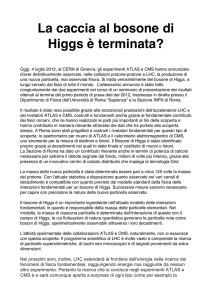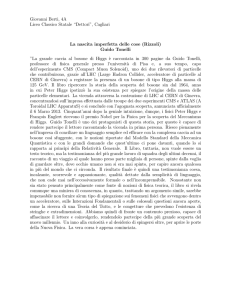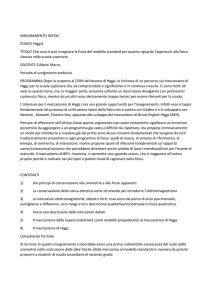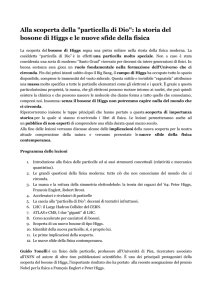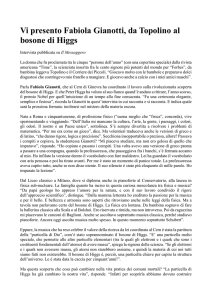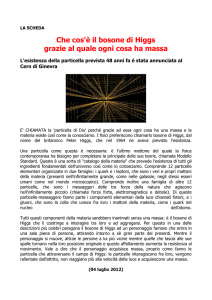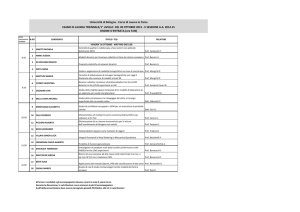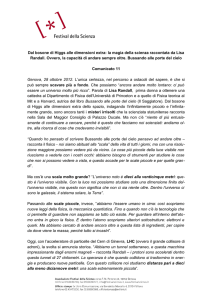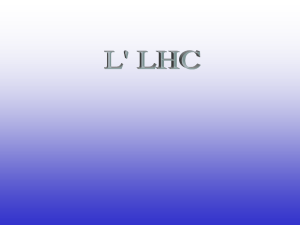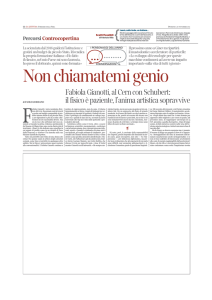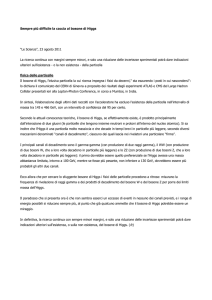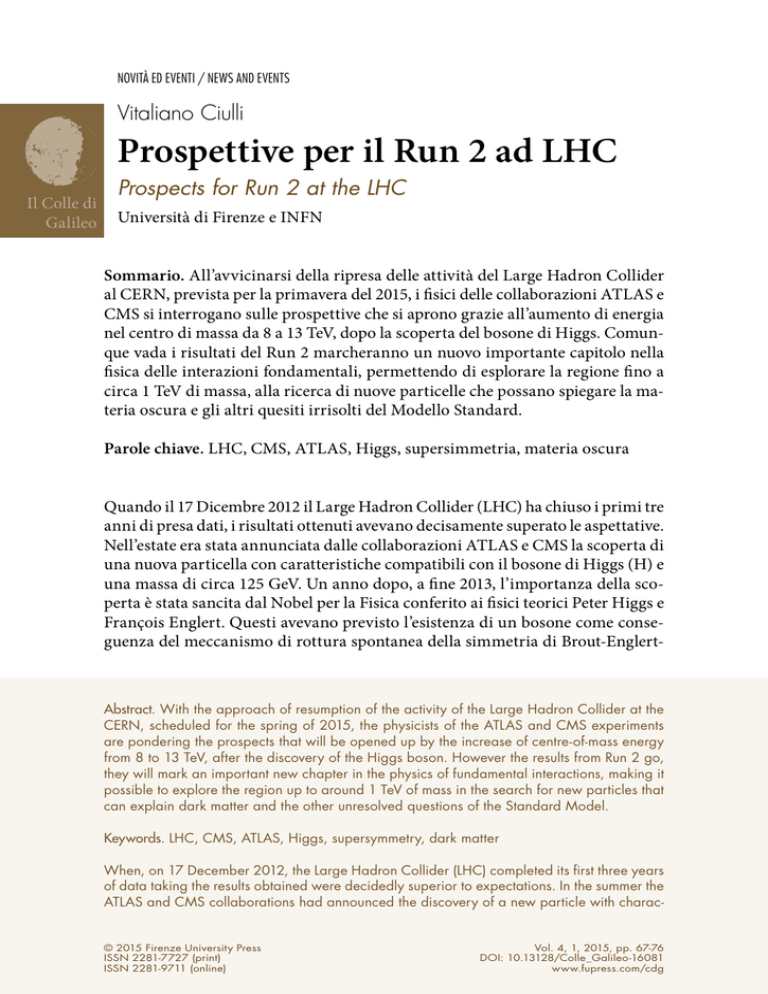
NOVITÀ ED EVENTI / NEWS AND EVENTS
Vitaliano Ciulli
Prospettive per il Run 2 ad LHC
Il Colle di
Galileo
Prospects for Run 2 at the LHC
Università di Firenze e INFN
Sommario. All’avvicinarsi della ripresa delle attività del Large Hadron Collider
al CERN, prevista per la primavera del 2015, i fisici delle collaborazioni ATLAS e
CMS si interrogano sulle prospettive che si aprono grazie all’aumento di energia
nel centro di massa da 8 a 13 TeV, dopo la scoperta del bosone di Higgs. Comunque vada i risultati del Run 2 marcheranno un nuovo importante capitolo nella
fisica delle interazioni fondamentali, permettendo di esplorare la regione fino a
circa 1 TeV di massa, alla ricerca di nuove particelle che possano spiegare la materia oscura e gli altri quesiti irrisolti del Modello Standard.
Parole chiave. LHC, CMS, ATLAS, Higgs, supersimmetria, materia oscura
Quando il 17 Dicembre 2012 il Large Hadron Collider (LHC) ha chiuso i primi tre
anni di presa dati, i risultati ottenuti avevano decisamente superato le aspettative.
Nell’estate era stata annunciata dalle collaborazioni ATLAS e CMS la scoperta di
una nuova particella con caratteristiche compatibili con il bosone di Higgs (H) e
una massa di circa 125 GeV. Un anno dopo, a fine 2013, l’importanza della scoperta è stata sancita dal Nobel per la Fisica conferito ai fisici teorici Peter Higgs e
François Englert. Questi avevano previsto l’esistenza di un bosone come conseguenza del meccanismo di rottura spontanea della simmetria di Brout-Englert-
Abstract. With the approach of resumption of the activity of the Large Hadron Collider at the
CERN, scheduled for the spring of 2015, the physicists of the ATLAS and CMS experiments
are pondering the prospects that will be opened up by the increase of centre-of-mass energy
from 8 to 13 TeV, after the discovery of the Higgs boson. However the results from Run 2 go,
they will mark an important new chapter in the physics of fundamental interactions, making it
possible to explore the region up to around 1 TeV of mass in the search for new particles that
can explain dark matter and the other unresolved questions of the Standard Model.
Keywords. LHC, CMS, ATLAS, Higgs, supersymmetry, dark matter
When, on 17 December 2012, the Large Hadron Collider (LHC) completed its first three years
of data taking the results obtained were decidedly superior to expectations. In the summer the
ATLAS and CMS collaborations had announced the discovery of a new particle with charac© 2015 Firenze University Press
ISSN 2281-7727 (print)
ISSN 2281-9711 (online)
Vol. 4, 1, 2015, pp. 67-76
DOI: 10.13128/Colle_Galileo-16081
www.fupress.com/cdg
68
Vitaliano Ciulli
Higgs, che permette di dare una massa alle particelle subatomiche nel Modello
Standard delle interazioni fondamentali.
Eppure gli auspici erano stati tutt’altro che favorevoli. L’inizio delle operazioni
di LHC era stato caratterizzato nel Settembre 2008 da un incidente ad una interconnessione tra i magneti superconduttori, che aveva messo in serio dubbio tutto
il progetto. Il problema riscontrato era subito apparso molto grave e sistemare le
interconnessioni tra tutti i 1200 magneti avrebbe richiesto molto tempo. Si decise
allora di proseguire con il programma diminuendo l’energia nel centro di massa
delle collisioni protone-protone: dai 14 TeV di progetto, a 7 TeV. A questa energia
l’acceleratore ha funzionato nel 2010 e nel 2011, quindi, incoraggiati dagli ottimi
risultati ottenuti e dai primi indizi dell’esistenza della nuova particella, nel 2012
si è deciso di aumentare l’energia a 8 TeV. Fatta eccezione per la minore energia,
l’acceleratore ha funzionato in modo eccellente, raggiungendo nell’ultimo periodo una luminosità istantanea, ovvero un numero di interazioni al secondo per
unità di sezione d’urto, pari a 7.7 x 1033 cm-2 s-1, molto vicina a 1034 cm-2 s-1 che era
la massima luminosità prevista. La quantità che però è più rilevante per i fisici
che hanno analizzato i dati è la luminosità integrata. Questa è misurata in femtobarn inversi (1fb-1 = 1039 cm-2) e nel corso dei tre anni di presa dati l’acceleratore
ha fornito ad entrambe gli esperimenti 25 fb-1. Considerando che la sezione d’urto di produzione di un bosone H è 20 pb, si ricava che sono stati prodotti in ciascun esperimento 500’000 H. Solo una piccolissima frazione di questi decade in
uno dei canali che possono essere distinti dal fondo enorme, ma questo è stato
sufficiente per scoprire la nuova particella.
teristics compatible with the Higgs boson (H) and a mass of around 125 GeV. A year later, at
the end of 2013, the importance of the discovery was endorsed by the Nobel Prize in Physics
awarded to the theoretical physicists Peter Higgs and François Englert. They had predicted the
existence of a boson as the consequence of the Brout-Englert-Higgs mechanism of spontaneous symmetry breaking, which makes it possible to give a mass to the subatomic particles in
the Standard Model of fundamental interactions.
And yet the auspices had been far from favourable. The start of operation of the LHC
had been marked in September 2008 by an accident involving the interconnection between the superconducting magnets which had seriously jeopardised the entire project.
The problem detected appeared immediately to be very serious, and fixing the interconnections between all 1,200 magnets would have taken a great deal of time. Consequently it was decided to proceed with the programme, diminishing the centre-of-mass energy
of the proton-proton collisions from the design energy of 14 TeV to 7 TeV. The accelerator
operated at this energy in 2010 and in 2011; then – encouraged by the excellent results
obtained and by the first clues of the existence of the new particle – in 2012 it was decided to increase the energy to 8 TeV. Leaving aside the lower energy level, the accelerator
functioned excellently, achieving in the final phase an instantaneous luminosity, that is, a
number of interactions per second per unit of reaction cross section, amounting to 7.7 x
1033 cm -2 s -1, very close to the 1034 cm -2 s -1 which was the expected maximum luminosity.
The quantity that is, however, most relevant for the physicists who analysed the data is the
Vitaliano Ciulli
Prospettive per il Run 2 ad LHC
Dopo l’annuncio della scoperta e la fine della presa dati, l’attività di analisi
non si è interrotta. I membri delle collaborazioni ATLAS e CMS hanno lavorato
per migliorare la precisione delle misure e poter così determinare se le sue proprietà sono effettivamente quelle previste nel Modello Standard. I risultati finali di questo lavoro sono stati presentati soltanto l’estate scorsa e in qualche caso
sono ancora preliminari. Finora non si sono trovate deviazioni significative da
quanto atteso dalla teoria. La natura scalare della particella sembra confermata con un livello di confidenza superiore al 99%. Anche il numero di eventi osservato nei vari decadimenti è compatibile con quanto aspettato. Tuttavia se la
scala di nuova fisica è sufficientemente elevata, gli effetti sugli accoppiamenti del
bosone H possono essere molto piccoli e dunque non rilevabili con la precisione
attualmente raggiunta.
Intanto, mentre nelle collaborazioni si continuava ad analizzare i dati, nel tunnel di LHC si lavorava alacremente per rimediare al problema delle interconnessioni difettose (Figura 1). Gli stessi esperimenti hanno fatto in questo periodo le
manutenzioni necessarie per garantire il miglior funzionamento possibile alla
ripresa delle operazioni. Ad esempio, in CMS si è posta molta cura nel risigillare
la parte più interna dell’esperimento, il tracciatore al silicio. Questo enorme strumento, alla costruzione del quale hanno contribuito i ricercatori del Dipartimento di Fisica dell’Università di Firenze e della sezione locale dell’Istituto Nazionale
di Fisica Nucleare, è costituito da 200 m2 di rivelatori al silicio capaci di misurare con una precisione di ~10 µm il passaggio di una particella. Per evitare che
le sue prestazioni si degradino a causa degli enormi livelli di radiazione ai quali
integrated luminosity. This is measured in inverse femtobarns (1fb -1 = 1039 cm -2) and in the
course of the three years’ data taking the accelerator provided 25 fb -1 to both the experiments. Considering that the production cross section for a H boson is 20 pb, it follows
that 500,000 H were produced in each experiment. Only a tiny fraction of these decay in
one of the channels that can be distinguished from the enormous background, but it was
sufficient to discover the new particle.
The analysis activity continued after the announcement of the discovery and the end of the
data collection. The members of the ATLAS and CMS collaborations worked to improve the
precision of the measurements, in order to establish whether the properties are effectively those
envisaged in Standard Model. The final results of this work were presented only last summer,
and in some cases they are still preliminary. To date no significant deviations from what was
to be expected from the theory have been found. The scalar nature of the particle appears to
be confirmed with a level of confidence of over 99%. The number of events observed in the
various decays is also compatible with what was expected. Nevertheless, if the scale of new
physics is sufficiently high, the effects on the coupling of the H boson can be very small and
therefore not detectable with the precision currently achieved.
In the interim, as the collaborations continued to analyse the data, in the tunnel of the LHC
work was being speedily carried out to repair the problem of the faulty interconnections (Figure 1). In this period the same experiments carried out the maintenance necessary to guarantee
the best possible functioning when operations are resumed. For example, in CMS great care
Prospects for Run 2 at the LHC
69
70
Vitaliano Ciulli
sarà esposto in futuro è però necessario raffreddarlo a -10ºC e a questa temperatura la minima presenza di umidità può provocare la formazione di ghiaccio
con danni irreparabili.
Come previsto dal programma dei lavori, LHC riprenderà a funzionare
nella primavera del 2015, con due importanti novità. La prima è l’incremento
dell’energia nel centro di massa a 13 TeV, in conseguenza del quale la sezione
d’urto di produzione per una particella dell’ordine di 100 GeV (come W, Z e
H) raddoppia; ma ben più importante è l’effetto per ipotetiche particelle con
una massa di 2 TeV, per le quali la sezione d’urto di produzione cresce addirittura di un fattore 10. Oltre all’energia, anche la luminosità aumenterà di circa un fattore due, raggiungendo 2×1034 cm-2 s-1 nel 2019, dopo uno stop di un
anno circa per il secondo long shutdown (LS2). Alla fine del Run 2, nel 2017,
si prevede che avremo raccolto 100 fb-1 che poi diventeranno 300 fb-1 nel 2021
alla fine del Run 3. Dopo l’acceleratore subirà nuovamente dei lavori importanti, questa volta per aumentare significativamente la luminosità. Infatti la
fase successiva è nota come High Luminosity LHC (HL-LHC). La speranza è
di poter raccogliere in un futuro non troppo remoto (intorno al 2030-35) un
Figura 1. Saldatura dell’interconnessione tra due magneti di LHC (Maximilien Brice, @CERN).
Figure 1. Welding of the interconnection between two magnets of the LHC (Maximilien Brice, @CERN)
Vitaliano Ciulli
Prospettive per il Run 2 ad LHC
fattore 10 in luminosità integrata, ovvero 3000 fb-1, e anche i rivelatori avranno bisogno di modifiche importanti per sostenere l’intensità necessaria a raggiungere questo obbiettivo.
Tuttavia già nel Run 2 gli esperimenti avranno di fronte delle sfide estremamente importanti. Prima fra tutte il problema del pile-up, ovvero della sovrapposizione di più collisioni di protoni in ogni singolo “evento” registrato dal rivelatore. Ci
si aspetta che il pile-up medio raggiunga valori intorno a 50, anche tenendo conto che la frequenza di collisione tra i fasci sarà raddoppiata, passando da 20 a 40
MHz. Come conseguenza, il tempo impiegato dagli algoritmi che ricostruiscono
le tracce lasciate da migliaia di particelle potrebbe esplodere se non si mettono
in atto le necessarie contromisure. Inoltre distinguere le particelle generate nella
collisione interessante da tutte le altre diventerà estremamente difficile e richiederà la messa a punto di nuove tecniche, sempre più elaborate, in una rinnovata
sfida tra le collaborazioni ATLAS e CMS.
D’altra parte la posta in gioco è molto alta. La scoperta del bosone di Higgs
ha modificato lo scenario sia per le misure di precisione che per la ricerca diretta
di nuova fisica. La fisica di precisione si concentra adesso sulla misura delle proprietà di questa nuova particella e dei suoi accoppiamenti con le altre particelle del Modello Standard. Come dicevamo pocanzi una piccola deviazione dalle
previsioni ci può dare indicazioni sulla scala alla quale dovrebbero manifestarsi
nuovi fenomeni. Allo stesso tempo lo spazio dei parametri per la ricerca diretta
di nuova fisica si è decisamente ristretto. Ma analizziamo più in dettaglio la situazione in entrambi gli ambiti di ricerca.
was taken to reseal the internal part of the detector, the silicon tracker. This enormous instrument, which was constructed with the contributions of the researchers from the Department of
Physics of the University of Florence and the local section of the National Institute of Nuclear
Physics, is made up of 200 m2 of silicon detectors capable of measuring the passage of a particle with a precision of ~10 µm. However, to prevent its performance deteriorating as a result
of the enormous levels of radiation to which it will be exposed in future, it has to be cooled to
-10ºC, and at this temperature even the minimal presence of humidity can cause the formation
of ice and consequent irreparable damage.
As scheduled in the works programme, the LHC will start operation again in the spring of
2015, with two important novelties. The first is the increase of the centre-of-mass energy to 13
TeV, as a result of which the production cross section for a particle of the order of 100 GeV
(such as W, Z and H) is doubled. However, the effect for hypothetical particles with a mass
of 2 TeV is much more significant, since for these the production cross section increases by no
less than a factor of 10. As well as the energy, the luminosity will also increase by around a
factor of 2, reaching 2×1034 cm -2 s-1 in 2019, after a stop of about a year for the second long
shutdown (LS2). At the end of Run 2 in 2017, it is predicted that 100 fb -1 of collision data will
have been collected, arriving at 300 fb -1 in 2021 at the end of Run 3. After this the accelerator
will again be subject to important works, this time to significantly increase the luminosity. The
next phase is in fact known as High Luminosity LHC (HL-LHC). The hope is that in the not-toodistant future (around 2030-35) it will be possible to reach a factor 10 of integrated luminosProspects for Run 2 at the LHC
71
72
Vitaliano Ciulli
Per quanto riguarda la fisica di precisione sono parecchie le misure che potranno essere migliorate significativamente. La massa dell’Higgs sarà determinata con una precisione migliore di 100 MeV, invece degli attuali 300 MeV, e
combinata alle misure sempre più precise della massa del W e del top, permetterà un verifica molto stringente della teoria. Gli accoppiamenti con i fermioni
e con i bosoni vettori potranno essere misurati con precisione migliore del 10%
(limitata dall’incertezza teorica sulla sezione d’urto). Questi accoppiamenti sono
particolarmente sensibili a fenomeni di nuova fisica, specialmente quando sono
generati da loop quantistici, come nel caso della produzione tramite gluon-gluon
fusion oppure nel decadimento in due fotoni. Un altro parametro importante è
la larghezza invisibile dell’Higgs, che in parecchi modelli è legata direttamente
alla materia oscura (Figura 2): con 300 fb-1 dovrebbe essere possibile mettere un
limite intorno al 25% della larghezza totale. Per la misura del potenziale di Higgs
dall’autoaccoppiamento, invece si dovrà quasi sicuramente attendere HL-LHC,
a meno di clamorose sorprese: alcuni modelli supersimmetrici prevedono infatti
una produzione molto più abbondante di coppie di bosoni di Higgs.
Proprio le teorie supersimmetriche continueranno ad essere il campo principale delle ricerche dirette di nuova fisica. Dopo la scoperta del bosone di Higgs,
il problema delle enormi correzioni quantistiche alla massa, è più pressante che
mai. Una soluzione naturale è la cancellazione di queste correzioni grazie all’esistenza delle particelle supersimmetriche, che hanno gli stessi numeri quantici
delle particelle del Modello Standard, ad eccezione dello spin. Tuttavia la naturalezza di questa soluzione viene meno se la terza generazione di squark, lo stop
ity, in other words 3,000 fb -1; the detectors too will require significant modifications to sustain
the intensity necessary to reach this objective.
However, even in Run 2 the experiments will already be addressing important challenges.
Foremost among these is the problem of pile-up, that is, additional proton-proton collisions
occurring in each individual “event” recorded by the detector. It is expected that the average
pile-up will reach values of around 50, even considering that the frequency of collision between the beams will be doubled, increasing from 20 to 40 MHz. In consequence, the time
employed by the algorithms that reconstruct the tracks of the thousands of particles could explode, unless the necessary countermeasures are implemented. Moreover, distinguishing the
particles generated in the collision of interest from all the others will become extremely difficult
and will call for the definition of new and increasingly elaborate techniques in a new challenge
between the ATLAS and CMS experiments.
On the other hand the stakes are very high. The discovery of the Higgs boson has altered
the entire scenario, in terms both of precision measurements and the direct search for new physics. Precision physics will now concentrate on the measurement of the properties of this new
particle and its couplings with the other particles of the Standard Model. As we mentioned
above, a small deviation from the forecasts can provide indications about the scale on which
new phenomena ought to appear. At the same time, the space of the parameters for the direct
search for new physics has been decisively narrowed. Let us now analyse the situation in both
fields of research in greater detail.
Vitaliano Ciulli
Prospettive per il Run 2 ad LHC
Figura 2. Limite superiore alla sezione d’urto tra materia oscura e nucleone dagli esperimenti di ricerca diretta e dal limite aspettato dalla larghezza invisibile del bosone di Higgs con l’esperimento ATLAS [1]. Tre
diversi scenari sono mostrati per lo spin della materia oscura: scalare, vettore o fermione di majorana. Le
area tratteggiate corrispondono all’incertezza sul fattore di forma del nucleone.
Figure 2. Upper limits of the dark matter-nucleon cross section from the direct search experiments and from the limit expected from the invisible width of the Higgs boson with the ATLAS experiment [1]. Three different scenarios are shown
for the spin of the dark matter: scalar, vector or Majorana fermion. The hatched areas correspond to the uncertainty
regarding the nucleon form factor.
As regards precision physics, there are many measurements that could be significantly improved. The mass of the Higgs will be determined with a precision of more than 100 MeV, as
opposed to the current 300 MeV and, combined with increasingly more precise measurements
of the W boson and the top quark, will enable a very stringent verification of the theory. It
will be possible to measure the couplings with the fermions and with the vector bosons with
a precision enhanced by 10% (restricted by the theoretical uncertainty of the cross section).
These couplings are particularly sensitive to the phenomena of new physics, especially when
they are generated by quantum loops, as in the case of production via gluon-gluon fusion or
in the decay into two photons. Another important parameter is the invisible width of the Higgs,
which in many models is directly linked to dark matter (Figure 2): with 300 fb -1 it ought to be
possible to set a limit of about 25% of the total width. Instead for the measuring of the Higgs’
self-coupling potential, barring sensational surprises, we will almost certainly have to wait for
the HL-LHC: in fact, some supersymmetrical models predict a much more abundant production
of pairs of Higgs bosons.
It is precisely the supersymmetry theories that continue to be the primary field of the direct
searches for new physics. Following the discovery of the Higgs boson, the problem of enormous
quantum corrections to the mass is more pressing than ever. A natural solution is the cancellation of these corrections resulting from the existence of supersymmetric particles, which have
the same quantum numbers as the particles of the Standard Model, excepting spin. However
this solution then loses its natural character if the third generation of squarks, the stop and the
Prospects for Run 2 at the LHC
73
74
Vitaliano Ciulli
e lo sbottom, sono troppo pesanti. L’estrapolazione delle analisi fatte a 8 TeV mostra che anche nelle ipotesi più pessimiste sulla stima dei fondi dovremmo essere in grado di osservare uno stop fino a valori della massa di 700 GeV (Figura 3).
Dunque si può immaginare che con il Run 2 le teorie supersimmetriche arriveranno ad un bivio. Certo non saranno completamente abbandonate nell’ipotesi
che non si osservino particelle supersimmetriche, ma una delle loro principali
attrattive, la naturalezza, verrà meno.
L’altra principale motivazione della supersimmetria è la spiegazione che fornisce per la materia oscura, che sarebbe dovuta alla particella supersimmetrica
neutra più leggera. Indipendentemente dall’esatta natura della materia oscura, c’è
un ampio consenso che il candidato debba essere una weakly interacting massive
particle (WIMP). Ad LHC è possibile rivelare coppie di WIMPs anche se la particella che media l’interazione con quark e gluoni del protone incidente non è nota
(in questo caso l’interazione viene descritta tramite una teoria effettiva caratterizzata dalla massa M* del mediatore). Infatti anche se le WIMPs sono invisibili
al rivelatore, è possibile identificarle come energia mancante nell’evento, grazie
alla presenza di un jet, un fotone o un’altra particella del Modello Standard che
rincula nella direzione opposta. Estrapolando i risultati ottenuti con una energia
di 8 TeV nel centro di massa, è ragionevole supporre che a 13 TeV sarà possibile
rivelare la materia oscura fino a valori della massa di circa 1 TeV.
Concludendo, dopo la scoperta del bosone di Higgs, la ripresa delle operazioni di LHC nel 2015 apre un nuovo interessante capitolo nel quale ci aspettiamo
di avere risposte quasi definitive riguardo all’esistenza di nuove particelle fino
sbottom, are too heavy. Extrapolation of the analysis made at 8 TeV demonstrates that, even
in the most pessimistic analyses about the estimate of the backgrounds, we ought to be able
to observe a stop up to mass values of 700 GeV (Figure 3). Therefore it is reasonable to suppose that Run 2 will bring the supersymmetry theories to a crossroads. Certainly, they will not
be completely abandoned in the event that supersymmetric particles are not observed, but one
of their principal attractions – their naturalness – will be lost.
The other principal motivation for supersymmetry is the explanation that it provides for dark
matter, namely that this is due to the lighter neutral supersymmetric particle. Irrespective of the
precise nature of dark matter, there is broad consensus about the fact that the candidate has
to be a weakly interacting massive particle (WIMP). At the LHC it is possible to detect pairs of
WIMPs even though the particle that mediates the interaction with the quarks and gluons of
the incident proton is not known (in this case the interaction is described through an effective
theory characterised by the mass M* of the mediator). Indeed, even though the WIMPs are
invisible to the detector, it is possible to identify them as missing energy in the event, through
the presence of a jet, a photon or another particle of the Standard Model that recoils in the
opposite direction. Extrapolating the results obtained with an energy of 8 TeV in the centre-ofmass, it is reasonable to assume that at 13 TeV it will be possible to detect the dark matter up
to mass values of around 1 TeV.
In conclusion, following the discovery of the Higgs boson, the resumption of operation of
the LHC in 2015 will launch a fascinating new chapter in which we expect to obtain almost
Vitaliano Ciulli
Prospettive per il Run 2 ad LHC
Figura 3. Proiezione per la scoperta a 5σ dello stop, nel caso di produzione diretta seguita dal decadimento in
top e neutralino, con l’esperimento CMS [2]. Nello scenario A segnale, fondo e incertezza sul fondo scalano
con la statistica. Nello scenario B, meno conservativo, l’incertezza relativa sul fondo si riduce.
Figure 3. Projection for the 5σ stop discovery, in the case of direct production followed by decay into a top and a neutralino, with the CMS experiment [2]. In scenario A signal, background and uncertainty on the background scale with
statistics. In the less conservative scenario B, the uncertainty relating to the background is reduced.
definitive answers regarding the existence of new particles up to the energy scale of TeV. With
or without supersymmetry, this region of energy is crucial in order to respond to the fundamental question about the naturalness of the theory, given that in the absence of new physics
at the TeV scale, the correction to the mass of the Higgs boson ought to be cancelled with an
accuracy of ε ≈ (125GeV/1TeV)2 ≈1%. The physicists of the experiments at the LHC have been
preparing for this exciting new challenge for some time, in the awareness that the road ahead
is still long and strewn with obstacles.
References
[1] ATLAS Collaboration, Projections for measurements of Higgs boson cross sections, branching ratios and coupling parameters with the ATLAS detector at a HL-LHC, ATL-PHYSPUB-2013-014, http://cds.cern.ch/record/1611186
[2] CMS Collaboration, Projected Performance of an Upgraded CMS Detector at the LHC and
HL-LHC: Contribution to the Snowmass Process, CMS-NOTE-13-002, arXiv:1307.7135 [hepex], http://arxiv.org/abs/1307.7135
Vitaliano Ciulli. After graduating from the Scuola Normale at Pisa, he went on to take his PhD
at the University of Pisa. Following a period spent at the CERN, he then became a researcher
Prospects for Run 2 at the LHC
75
76
Vitaliano Ciulli
alla scala di energia del TeV. Con o senza la supersimmetria questa regione di
energia è cruciale per rispondere alla domanda fondamentale sulla naturalezza della teoria, dato che in assenza di nuova fisica alla scala del TeV, le correzioni alla massa del bosone di Higgs dovrebbero cancellarsi con un’accuratezza ε ≈
(125GeV/1TeV)2 ≈1%. I fisici dell’acceleratore e degli esperimenti ad LHC si preparano già da tempo a questa nuova sfida entusiasmante, con la consapevolezza
che la strada da percorrere è ancora lunga e piena di difficoltà.
Bibliografia
[1] ATLAS Collaboration, Projections for measurements of Higgs boson cross
sections, branching ratios and coupling parameters with the ATLAS detector
at a HL-LHC, ATL-PHYS-PUB-2013-014, http://cds.cern.ch/record/1611186
[2] CMS Collaboration, Projected Performance of an Upgraded CMS Detector at the
LHC and HL-LHC: Contribution to the Snowmass Process, CMS-NOTE-13-002,
arXiv:1307.7135 [hep-ex], http://arxiv.org/abs/1307.7135
Vitaliano Ciulli. Laureato alla Scuola Normale di Pisa, ha conseguito il PhD all’Università di Pisa e dopo un periodo trascorso al CERN è diventato Ricercatore
all’Università di Firenze. Ha svolto la sua attività di ricerca prima al collisore LEP
nell’esperimento ALEPH e in seguito al collisore LHC nell’esperimento CMS. Si
è occupato di misure di fisica elettrodebole ed ha partecipato al disegno e alla costruzione del tracciatore al silicio di CMS.
at the University of Florence. He performed his research activity first at the LEP collider as part
of the ALEPH experiment and later at the LHC collider as part of the CMS experiment. He has
dealt with electroweak physics measurements and taken part in the design and construction
of the silicon tracker of CMS.
Vitaliano Ciulli

